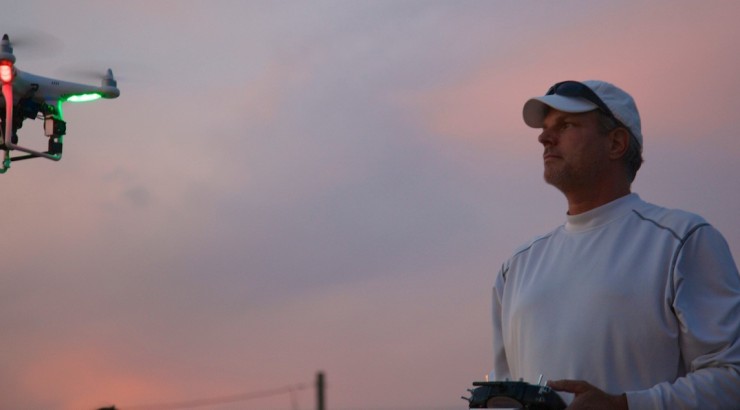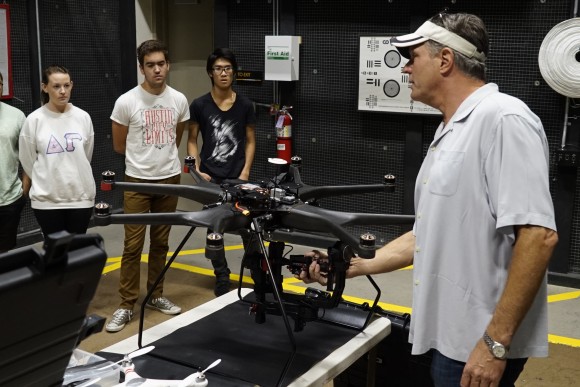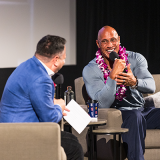Filmmaking By Remote Control
October 30, 2015
Years ago, when movies and television featured shots of sweeping vistas, panoramic sunsets, and flying over landscapes, filmmakers would need to go through a lengthy process of hiring a helicopter, mounting the camera rig, and actually flying over those areas to capture those beautiful visuals. It wasn’t cheap, but it resulted in amazing results.
Fast forward to 2015, and someone in their own backyard can accomplish the same for much, much less – with a drone.
While the word drone may initially conjure up visions of unmanned military aircraft, that is not even close to what is being used for filmmaking these days. Over the last five years, the technology behind drones has taken a huge leap, allowing for simple piloting systems and image stabilization.
The emergence of pilotless aircraft presents some very unique opportunities for filmmakers. With drones, things like aerial shots, and even crane shots, become much easier and more viable. Sweeping shots that were only viable with a flight crew and a large budget are relatively cheap with an inexpensive rig operated by a decent pilot today.
The Federal Aviation Administration is starting to allow the use of drones by aerial photography companies, working with Hollywood studios. With high-definition cameras getting more durable and compact, those formerly tough and expensive shots are only going to get easier. The cinematic possibilities are vast.
John-David Currey (BFA/Film and Television Production ’98) runs Fresh Cut Creative, a marketing company he created four years ago. Recently, the company opened Fresh Cut Above, a subdivision to shoot drone footage. What makes Fresh Cut Above unique is that it was one of the first to obtain the FAA exemption to allow it to legally obtain and sell drone footage. But the competition is heating up: Fresh Cut Above is now one of over 600 companies which has that exemption.
“I’ve always been a fan of aerial cinematography, for almost 25 years I strapped cameras to my radio-controlled air planes,” says Currey. “Now, people can get that high-end look for less than $3000, from what basically amounts to a toy. It’s amazing.”
Currey has thankfully had his pilot’s license for 15 years, which is one of the basic requirements to get the FAA exemption. He also follows the strict guidelines set out by the FAA to obtain his footage, such as not flying within a five-mile radius of an airport, having a safety person, a safety perimeter, and so on.
“It’s like the gold rush when it comes to drones right now. Everyone wants to do it, but you have to make sure you do it correctly,” Currey says.
Tyler Newman (BA/Public Relations and Advertising ’18) a current student, operates Pali Pictures, which also offers drone footage to its clients.
“I was doing an editing job for a vacation house in Mexico, and all the footage that was given to me was from a drone,” says Newman. “The shots looked incredible, and I realized that I needed to be able to take my own aerial footage in order to keep up with the progressing technology.”
Safety is paramount for all drone pilots, especially when it comes to the news stories that appear almost daily about crashes and accidents involving drones.
“For me, I just make sure to take extra precautions when I fly to avoid any malfunctions,” says Newman. “I learned all the aspects of the drone first, and I read the manual for a long time, when I really just wanted to start flying it. That helped me in the long run.”
One of the most endearing aspects of drone filmmaking is the fact that they can literally go and get footage that used to be unattainable.
Good Morning America
recently did a story called “Game of Drones,” in which a company got a shot of an erupting volcano in Iceland, something that is much too dangerous for a human camera operator to go anywhere near. It was not only beautiful, but was also captured safely, from a pilot a mile away.
A larger part of that puzzle, according to Currey, is making sure the footage is used correctly.
“Drone footage is some of the least emotional and least personal footage out there,” Currey says. “It looks nice, but has no heart. You need to make sure it means something in the larger context of what you are doing. Trick is not just getting shots from above, but how it fits into greater story.”
Hollywood agrees, as many of their big name directors, such as James Cameron, are getting behind the drone movement. With bigger pushes to drone technology just down the line, more and more Hollywood productions are employing drones to capture shots that they could only dream of years ago.
“Right now, drone footage adds a cinematic element because aerial footage is something we only have really seen in theaters,” Newman says, “But I think this is going to change within the next couple years.”



